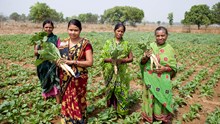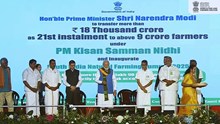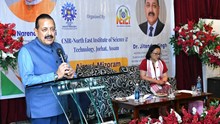
Watermelon is a popular summer fruit, known for its refreshing taste and high water content. Over recent years, the foothills of Arunachal Pradesh have become an emerging area for watermelon cultivation. This success is largely attributed to the introduction of improved open-pollinated varieties like Arka Shyama, developed by ICAR-IIHR. After field trials, Arka Shyama has shown excellent potential in terms of yield, marketability, and profitability, making it a promising crop for local farmers.
Introduction to Arka Shyama
In the summer of 2023, the Arka Shyama variety was trialed in a half-acre field at Jarkong village, located in the Pasighat area of East Siang district, Arunachal Pradesh. The trial was conducted to evaluate the variety's adaptability, performance, and profitability in the region's specific climatic and soil conditions. The seeds were sown in the last week of January 2023, with seedlings transplanted in February.
The plants were spaced 60 cm apart, following recommended agronomic practices to ensure healthy growth. The team of Multi-Technology Testing Center and Vocational Training Centre under the NEH component of ICAR-IIHR provided technical assistance and regular field monitoring throughout the growing season.
Crop Performance and Yield
Arka Shyama performed exceptionally well under the foothill conditions. The fruits matured in just three and a half months, with the first four harvests yielding an impressive 3 tonnes from the half-acre plot. The fruits averaged 2 to 3 kilograms in weight, making them ideal for small households.
With a wholesale price of Rs. 25 per kilogram and a retail price ranging between Rs. 35 and Rs. 40 per kilogram, the net profit from the crop reached approximately Rs. 1.6 lakh per half-acre. This result highlights the profitability and revenue-generating potential of this watermelon variety.
Unique Features and Market Demand
Arka Shyama is known for its uniform, medium-sized fruits that have a crisp, deep red flesh and a sweet, refreshing flavor. These characteristics make it attractive to both wholesale buyers and retail customers. The variety’s small size and excellent taste make it an ideal choice for city-dwelling customers looking for juicy, manageable-sized watermelons.
What sets Arka Shyama apart is that it is an open-pollinated variety, meaning farmers can save seeds for future planting, reducing input costs. Despite being an open-pollinated variety, Arka Shyama demonstrated performance comparable to that of commercial hybrids, which further boosts its appeal to farmers looking for cost-effective, high-yielding crops.
The consistent demand for Arka Shyama in domestic markets speaks to its commercial viability. Its marketability, appealing size, and delightful flavor have made it a popular choice, ensuring a steady income for farmers. With modest initial investment and a short cultivation period, Arka Shyama is becoming a profitable and sustainable option for farmers in the region.
Scope for Expansion and Farmer Motivation
The success of Arka Shyama in Arunachal Pradesh has already inspired many local farmers to adopt watermelon farming. The combination of low input costs, high market prices, and the professional support from ICAR-IIHR and local extension centers is motivating farmers to see watermelon as a viable alternative to traditional crops.
Arka Shyama offers a path to crop diversification, reducing the risks associated with mono-cropping or growing low-value crops. With proper training, awareness, and access to quality seeds, this variety holds the potential to improve the economic well-being of small and marginal farmers across the northeastern states.
Conclusion
Arka Shyama has the potential to revolutionize watermelon farming in the foothills of Arunachal Pradesh. Its short growth cycle, excellent fruit quality, and profitable returns make it an attractive crop for farmers seeking a low-risk, high-reward alternative.
By spreading awareness and providing ongoing support through ICAR-IIHR’s research and extension programs, the success of Arka Shyama could pave the way for a more sustainable and profitable agricultural landscape in the region, improving the livelihoods of farmers in this isolated yet promising area.
















